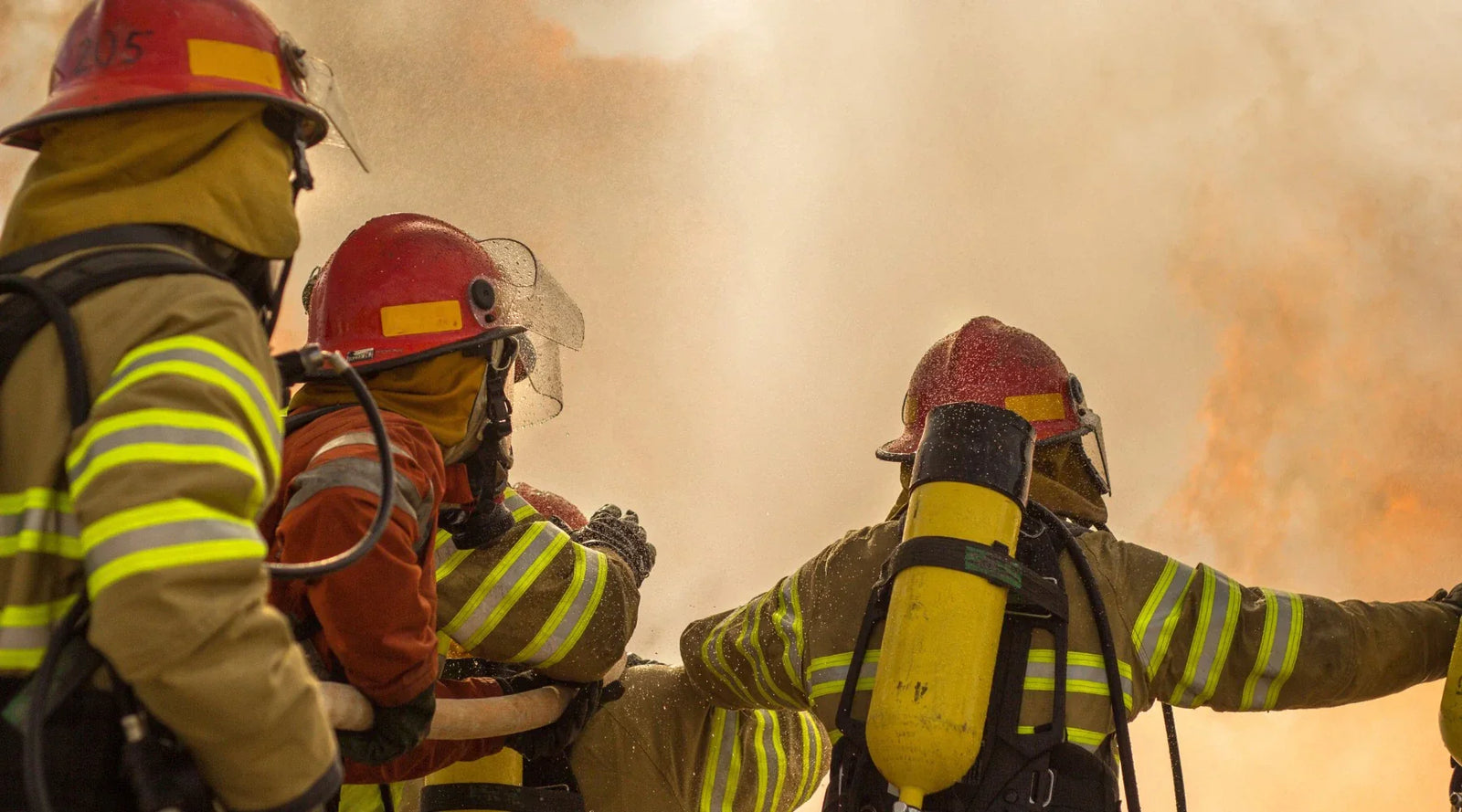Preparing for a wildfire requires a comprehensive approach that protects both life and property. This means creating defensible space around your home, hardening your house against flame and ember intrusion, assembling emergency supplies, developing evacuation plans, and staying informed about fire risks.
For indoor safety, it’s also important to consider how you’ll maintain clean air during smoke events — investing in a quality air purifier can help safeguard your respiratory health when outdoor air becomes hazardous.
But what should you prioritize first? Which protection measures actually save homes when others fail? This guide reveals the essential wildfire defense strategies that could mean the difference between devastating loss and successful protection of your family and property.
Assess Your Wildfire Risk
Wildfires have become increasingly frequent and severe, making proper preparation essential if you live in at-risk areas. Understanding your specific wildfire risk factors is the first critical step in effective preparation.
Your location significantly impacts your wildfire risk level. Very high-risk areas include mountainous terrain with hot, dry summers and dense vegetation. High-risk areas include foothills and rural-urban interfaces with seasonal drought conditions. Some regions face significantly higher wildfire threats, particularly the Western United States (California, Oregon, Washington), Southwest (New Mexico, Texas), Mountain West (Montana, Idaho), and parts of Canada.
Evaluate your property's specific risk factors using this checklist:
-
Topography Considerations
-
Properties on slopes face increased risk (fire travels uphill quickly)
-
South-facing slopes typically experience hotter, drier conditions
-
Access Evaluation
-
Limited evacuation routes increase risk
-
Narrow roads may become impassable during emergencies
-
Surrounding Vegetation Analysis
-
Dense trees within 100 feet of structures
-
Presence of ladder fuels allowing fire to climb from ground to tree crowns
-
Structural Vulnerabilities
-
Wooden roof materials or untreated wood siding
-
Open eaves and vents without proper protection from wildfire smoke components
Several resources can help assess your risk, including the U.S. Forest Service, insurance company evaluations, and local fire department consultations.
Create a Defensible Space Around Your Home
Defensible space is the buffer between buildings and surrounding vegetation that slows or stops wildfire spread. If you carefully maintain this area, it helps protect your home from direct flame contact and reduces ignition from flying embers.
Zone 1: Immediate Home Protection (0-30 feet)
This critical zone requires rigorous maintenance:
-
Remove all dead vegetation including fallen leaves and branches.
-
Keep roofs and gutters clear of debris.
-
Trim tree branches at least 10 feet from your roof.
-
Remove highly flammable plants and replace with fire-resistant options.
-
Separate tree crowns by at least 10 feet.
-
Move firewood and propane tanks at least 30 feet from structures.
-
Use non-combustible mulch near buildings.
-
Keep grass mowed to maximum 4-inch height.
Zone 2: Reducing Fuel (30-100 feet)
This intermediate zone focuses on reducing fire intensity:
-
Create horizontal spacing between vegetation using the 2-2-6 rule (see below).
-
Maintain vertical separation of at least 6 feet between ground vegetation and tree branches.
-
Remove small conifers growing between mature trees.
-
Create fuel breaks with driveways and gravel walkways.
-
Thin tree canopies while maintaining 60-70% shade coverage.
What’s the 2-2-6 rule? This set of brush management guidelines refers to:
-
2 feet of clearance between the ground and the bottom of shrubs.
-
2 times the height of the shrub between the top of the shrub and the lowest tree branches.
-
6 feet of clearance between the ground and the lowest branches of trees.
Zone 3: Managing Vegetation (100+ feet)
This extended zone focuses on reducing fire energy:
-
Thin trees to create space between canopies.
-
Remove heavy accumulations of woody debris.
-
Create strategic firebreaks along property lines.
-
Maintain access roads with vegetation cleared.
Maintaining defensible space requires regular seasonal maintenance, from spring cleanup to fall preparation, making it an important part of your wildfire and wildfire smoke protection strategies rather than a one-time project.
Home Hardening: Making Your House Fire-Resistant
Home hardening involves modifying your house to increase its resistance to wildfire damage. These structural improvements can dramatically improve your home’s chances of surviving a wildfire.
Roof and Gutter Protection
The roof is your home's most vulnerable part during a wildfire:
-
Replace wood shake roofs with Class A fire-rated materials.
-
Install bird stops at the ends of barrel-style tiles.
-
Repair loose or missing shingles before fire season.
-
Install non-combustible gutter guards.
-
Regularly clear debris from roof valleys.
Windows, Vents, and Entry Points
Embers can enter through tiny openings:
-
Install dual-pane windows with tempered glass.
-
Add metal mesh screens (1/8-inch or finer).
-
Replace plastic window frames with metal or fiberglass.
-
Cover all vents with 1/8-inch metal mesh.
-
Access emergency wildfire resources and information for additional protection methods.
Siding and Exterior Materials
Choose fire-resistant materials:
-
Stucco, fiber cement, brick, or metal siding.
-
Ensure siding extends to ground level without gaps.
-
Box in open eaves with fire-resistant materials.
-
Create a vertical non-combustible zone between ground and siding.
Deck and Porch Modifications
-
Build with fire-resistant materials like heavy timber or composites
-
Enclose areas under decks with 1/8-inch metal mesh
-
Keep area under decks clear of combustibles
-
Maintain 3-foot vegetation-free zone around decks
Cost-effective upgrades for existing homes include replacing missing roof tiles, installing metal gutter guards, covering vents with metal mesh, and implementing special precautions for respiratory conditions, such as asthma and allergies brought on by wildfires, during fire season.
Protect Your Indoor Air Quality
Even with proper defensible space and home hardening, smoke infiltration remains a significant concern during wildfire events. Protecting your indoor air quality is crucial for maintaining your health during prolonged smoke exposure.
Modify Your HVAC System
Your home's heating and cooling system plays a critical role in wildfire smoke defense:
-
Install MERV 13 or higher-rated filters in your HVAC system.
-
Create a clean air zone in your home by setting up a room with minimal exterior walls.
-
Consider installing an inline HEPA filtration system.
-
Regularly replace filters during fire season, more frequently than your normal schedule.
-
Set your system to recirculation mode during smoke events.
-
Install a programmable thermostat to control fan operation.
-
Seal any leaks in ductwork that could draw in outdoor air.
These modifications help reduce the recognizable wildfire smoke odor that can permeate homes during wildfire events or even help you get rid of that fire smoke smell completely.
Invest in Air Purification Solutions
Standalone air purifiers provide additional protection beyond HVAC filtration:
-
Select air purifiers that work for wildfire smoke removal.
-
Look for true HEPA filtration with a substantial activated carbon air filter.
-
Calculate appropriate size based on room square footage.
-
Determine where to put your air purifiers in bedrooms and main living areas.
-
Consider advanced technologies that destroy rather than just trap pollutants.
-
Run air purifiers for smoke continuously during smoke events.
-
Keep replacement filters on hand before fire season begins.
In severe smoke conditions, creating a designated clean room with sealed doors and windows and multiple home air purifiers provides the highest level of protection.
Use Home Sealing Strategies
Prevent smoke infiltration by sealing common entry points:
-
Apply weatherstripping around doors and windows.
-
Use caulk to seal gaps around pipes, vents, and utility penetrations.
-
Install door sweeps on exterior doors.
-
Cover window air conditioners or remove during smoke events.
-
Consider temporary plastic sheeting over windows in extreme conditions.
-
Close fireplace dampers and cover with plastic if not in use.
-
Seal mail slots and pet doors when not needed.
Combining these sealing techniques with filtration dramatically reduces indoor smoke levels, helping to protect vulnerable family members from respiratory complications.
Emergency Supply Kit Essentials
Your emergency kit should be ready to support you during an evacuation or shelter-in-place order during a wildfire event. Here’s a checklist you can use to ensure your kit is comprehensive.
Water and Food Supplies
-
Store one gallon of water per person per day for at least three days.
-
Include a two-week food supply of non-perishable items.
-
Choose foods requiring minimal preparation and water.
-
Include pet food and water for all animals.
-
Rotate supplies regularly to ensure freshness.
-
Store in easily accessible, grab-and-go containers.
-
Include manual can opener and eating utensils.
Safety and First Aid Items
-
N95 respirator masks (one per family member per day for expected duration).
-
First aid kit including burn treatment supplies.
-
Prescription medications (two-week supply).
-
Flashlights and extra batteries.
-
Emergency radio (battery-powered or hand-crank).
-
Fire extinguisher.
-
Whistle to signal for help.
-
Tools for shutting off utilities.
Documents and Communication
-
Keep copies of important documents in a waterproof container:
-
Insurance policies
-
Identification
-
Bank records
-
Medical information
-
Emergency contact list
-
Include cash in small denominations.
-
Battery packs for mobile phones.
-
Physical maps of your area with evacuation routes marked.
-
Emergency family communication plan (meeting points, out-of-area contacts).
Store these supplies in easily accessible locations and review them before each fire season to ensure everything remains current and functional.
Plan Your Evacuation: Know When and How to Leave
Having clearly defined evacuation procedures can save your life when minutes count during a fast-moving wildfire.
Create and Practice Evacuation Routes
-
Identify at least two exit routes from your neighborhood.
-
Map multiple destinations depending on fire direction.
-
Practice driving these routes under different conditions.
-
Identify potential bottlenecks and alternatives.
-
Account for pets and livestock in your planning.
-
Establish meeting locations if family members are separated.
-
Share plans with neighbors for potential assistance.
-
Keep vehicle fuel tanks at least half full during fire season.
Be Familiar With Evacuation Warning Levels
Understanding official evacuation terminology will ensure you know how to respond appropriately when the time to act comes. Don't wait for official evacuation orders if you observe concerning conditions such as rapidly approaching flames, heavy smoke, or strong winds driving a nearby fire.
Below is a table outlining different warning levels and your recommended actions.
|
Warning Level |
What It Means |
Recommended Actions |
|
Evacuation Alert/Advisory |
Fire threatening, evacuation may be needed |
Prepare to leave, gather supplies, load vehicles. |
|
Voluntary Evacuation |
Significant threat exists |
Leave if you have health concerns, children, pets, or limited mobility. |
|
Mandatory Evacuation |
Imminent danger to area |
Leave immediately — don’t delay. |
What to Take When Evacuating
Prioritize the "Six P's" during evacuation:
-
People and pets: Most important priority
-
Papers: Important documents and information
-
Prescriptions: Medications and medical equipment
-
Pictures: Irreplaceable photos and memorabilia
-
Personal computer: Electronic devices and data
-
Plastic: Credit cards and cash
Load these items following your pre-planned checklist rather than making decisions under stress. Keep a clean breathing environment in your vehicle by running the air conditioning on recirculate mode with the windows closed during evacuation.
When you’re properly prepared with comprehensive plans and supplies, you significantly increase your chances of safely navigating the challenges posed by wildfire events, protecting both your family and property.
Neighborhood Wildfire Preparedness
Individual preparation is essential, but community-level coordination dramatically improves everyone's safety during wildfire events. These networks prove invaluable during evacuations, when your safety depends on quick action and mutual assistance.
Consider establishing a neighborhood wildfire network and creating connections with your neighbors:
-
Organize a neighborhood meeting focused on wildfire preparedness.
-
Create a contact list with phone numbers, emails, and special needs.
-
Identify residents with useful skills (medical, construction, etc.).
-
Establish block captains responsible for checking on vulnerable neighbors.
-
Share evacuation plans and meeting points.
-
Coordinate community-wide defensible space projects.
-
Create a neighborhood communication plan for emergencies.
-
Consider forming a Community Emergency Response Team (CERT).
Community-Wide Preparedness Projects
Collective action enhances protection beyond individual properties. These collaborative efforts often qualify for support from wildfire protection programs and forestry agencies.
-
Organize neighborhood clean-up days to reduce common area fuels.
-
Share equipment for vegetation management.
-
Apply for community wildfire mitigation grants.
-
Create community-wide evacuation drills.
-
Improve neighborhood signage for emergency responders.
-
Develop community fire breaks at strategic locations.
-
Maintain communal water sources for firefighting.
Local Alert Systems and Information Sources
Test your alert reception periodically and keep your devices charged during high fire danger periods. Register for multiple emergency notification systems:
-
Wireless Emergency Alerts (WEA)
-
County-specific alert systems (often require registration)
-
NOAA Weather Radio alerts
-
Local fire department social media accounts
-
Community phone trees or text groups
-
Emergency mobile apps specific to your region
-
Scanner apps for monitoring emergency radio traffic
Recovery Planning: Preparing for the Aftermath
Having a post-wildfire plan in place before disaster strikes facilitates faster recovery. Three areas to focus on include your insurance coverage, post-fire safety, and long-term recovery.
1. Insurance Documentation and Coverage
Take these steps before fire season begins:
-
Review insurance policies for adequate coverage.
-
Document home contents with photos and videos.
-
Store inventory records in multiple locations (cloud, safe deposit box).
-
Understand policy limits and exclusions.
-
Consider additional coverage for extended living expenses.
-
Know your insurer's claims process and contact information.
-
Keep policy information in your evacuation kit.
Complete documentation significantly improves claim outcomes if your home suffers wildfire damage.
2. Post-Fire Safety Considerations
If you’re returning after an evacuation:
-
Wait for official clearance before returning.
-
Be aware of hazards like fallen power lines and unstable trees.
-
Check for hot spots, smoldering areas, or structure damage.
-
Have utilities inspected before turning them back on.
-
Wear appropriate protective gear (boots, gloves, masks).
-
Be cautious of ash and debris that may contain toxic materials.
-
Monitor air quality conditions before opening windows.
3. Long-Term Recovery Resources
Familiarize yourself with the channels of assistance that are available to you after a wildfire:
-
FEMA disaster assistance programs
-
Small Business Administration (SBA) disaster loans
-
State emergency management resources
-
Non-profit organizations providing recovery support
-
Tax relief options for disaster victims
-
Mental health resources for post-disaster stress
-
Community rebuilding initiatives
Remember that wildfire preparation offers benefits beyond emergency situations. Many of these improvements, particularly home air quality enhancements, provide daily health advantages even when fires aren't threatening. Your investment in preparation creates both immediate safety and long-term resilience.
Frequently Asked Questions
How often should I maintain my defensible space?
Inspect your area monthly during fire season and perform major maintenance at least twice yearly — in the spring before fire season and in the fall to remove accumulated debris.
What's the most cost-effective home hardening measure?
Replacing your vent screens with 1/8-inch metal mesh provides exceptional protection for relatively low cost, as ember intrusion through vents is a primary cause of home ignition.
Should I evacuate even if the fire seems far away?
Yes, evacuate early when authorities issue warnings. Wildfires can move extremely quickly, and late evacuation is dangerous.
What if I can't afford expensive home modifications?
Focus on free or low-cost measures first: maintaining your defensible space, sealing gaps and vents, removing flammable items from around your home, and having a solid evacuation plan.
How can I protect my indoor air quality during wildfires?
Use appropriate air filtration systems, create a clean room with sealed doors and windows, and run HVAC systems with high-efficiency filters on recirculation mode.







